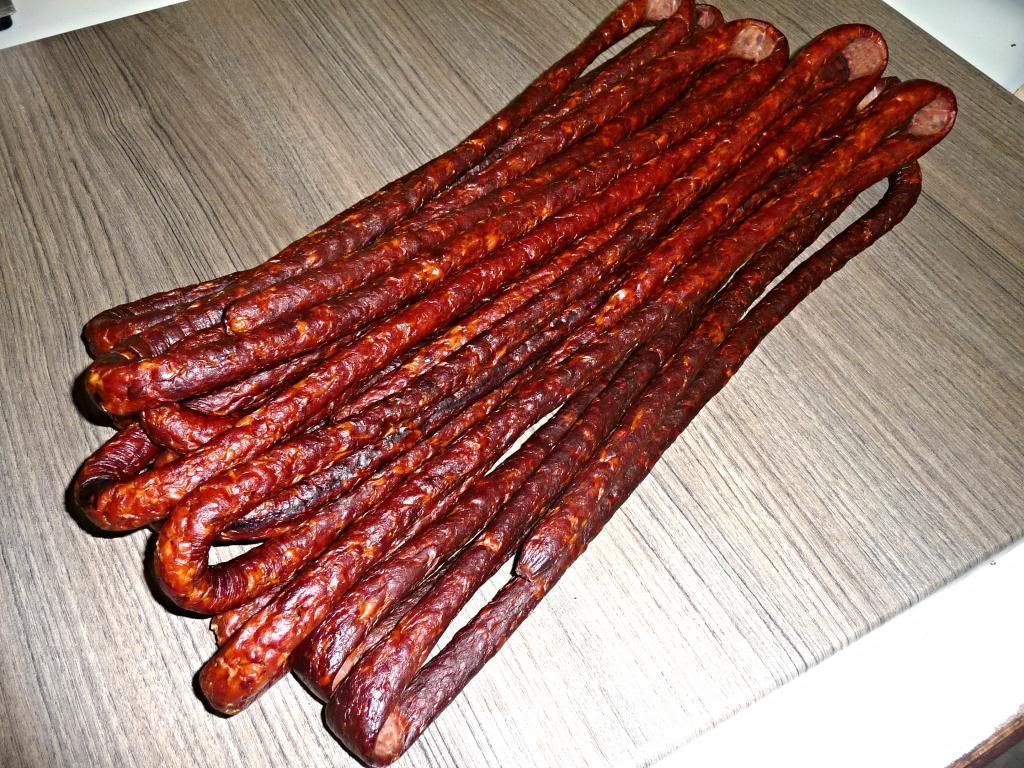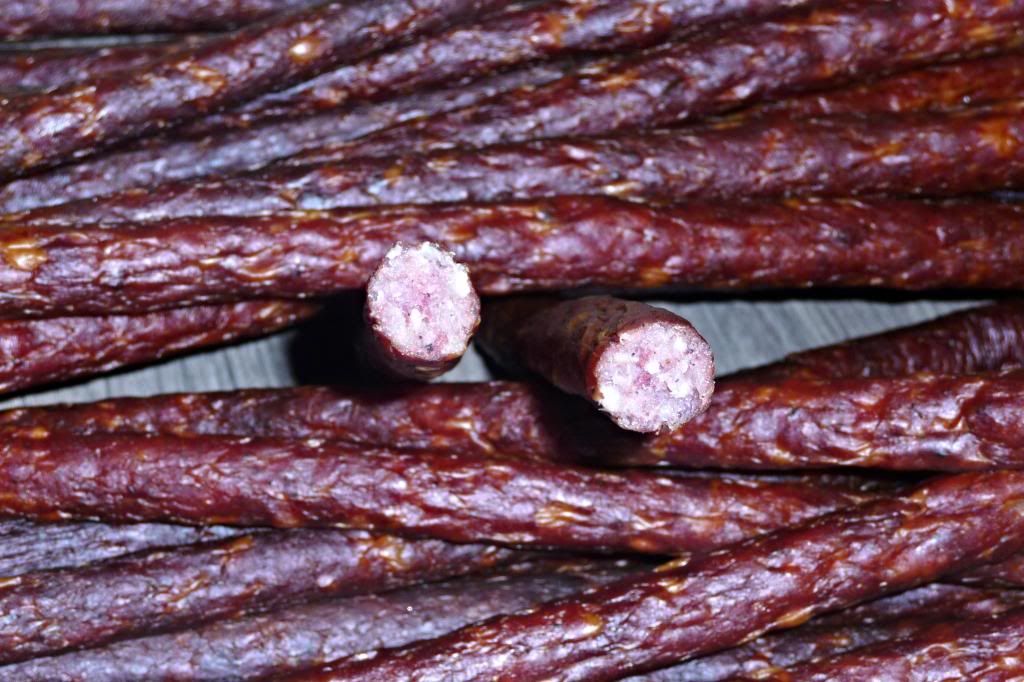Okay kids, before we leave the "fresh sausage" section, let`s make one last effort to create the perfect sausage -
your own! Let`s make about three pounds of it. Yup, if you`ve done your reading and have made a few sausages, you`ve learned that the real secret of crafting great sausage lies within HOW you make it rather than focusing too much on what goes into the sausage. Of course great sausage must have great ingredients but there is more to it than that. Let`s understand right up front that good sausage is NOT made of odds and ends, scrap pieces, and leftovers, as so many people seem to believe. There are a number of small procedures and specific rules to remember, as well as things we must NOT do. When the guidelines are followed, sometimes even in sequence, your chances of success are much greater. However, omit just one and you may as well start again.
Just for fun, let`s first consider an imaginary sausage and use some of the newly discovered secrets from the Project B2 reading. Let`s say you have decided to make a garlic-basil-red wine sausage and put it into casings to be frozen for future breakfast recipes. Just the right amount of each "secret ingredient" seemed to work a kind of magic when you accidentally put them together the first time. Wow, this stuff is marvelous and sure to get the attention of all your family and friends at first, then the general public later on. Your recipe is going to be legendary, right? Perhaps people will beat a path to your front door just to lay their hands on some of your sausage! Uhhh... okay... right!

Okay, you`ve purchased the best meat and will keep it cold while you work in batches to process it. First you bone the shoulder and then cut the meat across the grain into cubes so that long strands won`t wrap around the auger spindle. You even go so far as to sharpen the rotating knife and place the metal parts of your grinder into the freezer. The casings have even been flushed and prepared just perfectly and everything is ready to go. The fresh spices have been measured and put aside ready to mix. You`ve even included your own basil from your garden out back. The grinding begins and everything goes perfectly. You`re going to make garlic-basil sausage that will knock their socks off because only you know the next secret ingredient... a cup of uncle Albert`s burgundy vino fino! Alas, everything comes together and the aroma is driving you nuts! Now, cover the sausage and refrigerate it until the morning until you can toss some into the frying pan and put the rest in casings.
Nine o`clock A.M. You slept in an hour because it`s the weekend. Now to cook up some of that great sausage for breakfast. You open the fridge, take out the sausage lug and remove the top when... whew! What the heck is that? This is not an aroma... this is an odor! And what an odor! It smells like your cousin Clem`s old gym socks - the ones that stand up by themselves and wilted the leaves on the roses! What has happened? What went wrong? Ten pounds of good meat and a lot of work are just tossed out!
The plain truth is making a quality sausage requires a little knowledge of meat science and the rules that manage them. And the rules must be followed. In the case above, we cannot add fresh garden spices to the mixture because they contain bacteria, molds, and sometimes even insects. Aerobic Pseudomonas (spoilage bacteria ) have a ball multiplying quickly in the moist, nutrient-laden meat.
Spoilage Bacteria
Don`t confuse
pathogenic bacteria with
spoilage bacteria. Pathogenic bacteria cause illness. They grow rapidly in the "Danger Zone" at temperatures between 40 and 140 °F. and do not generally affect the taste, smell, or appearance of food. Food that is left too long at unsafe temperatures could be dangerous to eat, but smell and look just fine. Campylobacter, Salmonella, and E. coli O157:H7 are examples of pathogenic bacteria.
Spoilage bacteria reproduce at specific temperatures and some can grow at the low temperatures inside your refrigerator or even your freezer. Other spoilage bacteria grow well at room temperature and anywhere within the "Danger Zone." Bacteria will grow anywhere they have access to nutrients and water and under the correct conditions, spoilage bacteria may reproduce extremely rapidly in large populations. Spoilage bacteria can actually double their numbers in as little as 20 minutes and it doesn`t take long for a large number of microorganisms and their waste products to cause objectionable changes in odor, taste, and texture. P.U.

Brochotrix thermosphacta and Pseudomonas spp. are examples of spoilage bacteria.
It`s All About The Temperature
Mesophilic bacteria (the largest and most common group) are those that grow best in moderate temperatures - about 70° to 98° F. but mesophiles can also grow at only 45° degrees and up to 110° degrees, but they do so more slowly.
Some like it hot!
Thermophilic bacteria live and multiply best at approximately 130° degrees F. but can grow anywhere between 110° and 190° degrees F.
Psychrophilic bacteria grow from 32° to 90° degrees F. Most thrive at 50° to 70° degrees. Because they grow better NOT best than the mesophilic bacteria at refrigerated temperatures--32 to 45 degrees--, this group is most often responsible for spoilage in refrigerated foods.
Contrary to the belief of many people, cold or freezing does not always kill bacteria. Make no mistake! In most cases it just stops or slows down their growth. The FSIS rules require "extended freezing" with prescribed lengths of time at precise temperatures to slowly kill them. Also, bacteria need water to grow and even though some of them have the ability to resist long drying out periods, keeping things dry will stop growth and in some instances will kill them. Generally, bacteria responsible for spoilage of foods (mesophilic and psychrophiles) can be killed by hot water. Ten minutes at 150 degrees F. will be sufficient. However, there are some strains so resistant that germicides such as chlorine and quaternary ammonium compounds are required to control them.
Making your own sausage recipe
It really doesn`t take long to discover that the best sausage is made of meat, salt, and pepper only. Yet, just one or two favorite spices may add just the right personal touch to your project. Believe me,
if you get carried away adding all sorts of spices and herbs, you`ll just have ten pounds of sausage you don`t want to eat and can`t give away! Why not fry up just a
simple sample "test" paddy and keep meticulous notes?
Your recipe will need a bit of salt - un-iodized salt that is! About 1-1/2 to 2% in fresh sausage. It`s there to hold water, bind proteins, flavor the meat, firm the meat, and prevent loss of water when it is cooked. How much do you need? Weigh the meat in grams - for every 100 grams of meat, simply add 2 grams of salt.
Next, you`ll need to add some backfat to your sausage. Put in about 25% for best results. Thirty percent is alright if you want just a bit more for smooth chewing texture, but I suggest avoiding two things - beef fat and fat content above 30%. By the way, did you know that your local grocery store butcher can legally put 50% fat in his sausage. (And we wonder where all the grease comes from in the bottom of the frying pan.)
Mother nature made a curious occurrence by placing the hardest fats near the interior of the piggy. The further the distance from the center of the animal, the softer it becomes. Backfat is ideal. And, please use pork fat - that`s where the flavor is, believe me.
Piper nigrum is pepper. Both white pepper and black pepper are grown by the same plant although black pepper is mostly used in fresh sausage. It is added in amounts varying from .1% to .4% in meat.
Spices are the most controversial ingredients in sausage. The choices are actually more limited than you may believe as many spices just do not do well in sausage. An excellent guideline for their use is given in chapter 12 of "
Home Production Of Quality Meats And Sausages" by Stan Marianski. Various cultures over time have given us "signature spices". For instance, the addition of marjoram and garlic are common in Polish sausages, while Italian sausage uses fennel. The addition of cayenne gives us hot Italian sausage, while Hungarian sausage uses sweet Hungarian paprika. Andouille is distinguished by the addition of thyme with garlic, and our delicious kabanosy is made using nutmeg and caraway. Which spice will be your secret ingredient? Or will you even have a secret ingredient?
In the next section, we`ll learn how to add the proper sodium nitrite cure in the right amount and then even smoke it. We`ll take your same recipe, add the cure, stuff the sausage into casings, and find that it changes the entire character of your sausage. Perhaps you`ll grill it, boil it, broil it or even bake it in smoke.
For now, make a "fresh" sausage. Your own! Remember not to smoke it (without a cure being added). Please keep good notes and write down all the details. Take photos too. Show us some preparation steps as well as some finished on the plate. And give your sausage an original name! Who can tickle the taste buds with this project? Go team, go!
Please read:
Sixteen Tips For Writing A Professional Recipe at this link:
http://wedlinydomowe.pl/en/viewtopic.php?t=5838
Best Wishes,
Chuckwagon






but I messed up with the Kabanosy.
The day before I seasoned my new Cabella's Pro 100 smoker and smoked a couple of yardbirds for a test. Seemed to work Ok, but looks like I have to learn to use it a bit better. Sparing all the details, I over smoked the sausage and over cooked it. They are barely edible, having a considerable amount of bitterness that overtakes the nutmeg and caraway flavours. Rather than improving, I'm sliding backwards. My first batch of Kabanosy were superb and did not last long. These will be shared with the neighbourhood canines.


.


